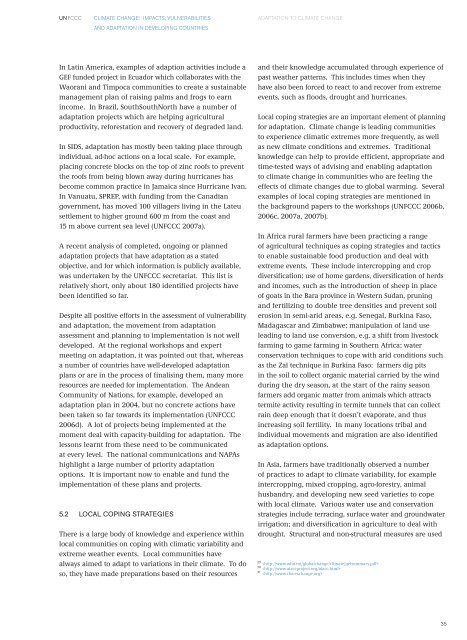impacts
You also want an ePaper? Increase the reach of your titles
YUMPU automatically turns print PDFs into web optimized ePapers that Google loves.
UNFCCC<br />
CLIMATE CHANGE: IMPACTS, VULNERABILITIES<br />
AND ADAPTATION IN DEVELOPING COUNTRIES<br />
ADAPTATION TO CLIMATE CHANGE<br />
In Latin America, examples of adaption activities include a<br />
GEF funded project in Ecuador which collaborates with the<br />
Waorani and Timpoca communities to create a sustainable<br />
management plan of raising palms and frogs to earn<br />
income. In Brazil, SouthSouthNorth have a number of<br />
adaptation projects which are helping agricultural<br />
productivity, reforestation and recovery of degraded land.<br />
In SIDS, adaptation has mostly been taking place through<br />
individual, ad-hoc actions on a local scale. For example,<br />
placing concrete blocks on the top of zinc roofs to prevent<br />
the roofs from being blown away during hurricanes has<br />
become common practice in Jamaica since Hurricane Ivan.<br />
In Vanuatu, SPREP, with funding from the Canadian<br />
government, has moved 100 villagers living in the Lateu<br />
settlement to higher ground 600 m from the coast and<br />
15 m above current sea level (UNFCCC 2007a).<br />
A recent analysis of completed, ongoing or planned<br />
adaptation projects that have adaptation as a stated<br />
objective, and for which information is publicly available,<br />
was undertaken by the UNFCCC secretariat. This list is<br />
relatively short, only about 180 identified projects have<br />
been identified so far.<br />
Despite all positive efforts in the assessment of vulnerability<br />
and adaptation, the movement from adaptation<br />
assessment and planning to implementation is not well<br />
developed. At the regional workshops and expert<br />
meeting on adaptation, it was pointed out that, whereas<br />
a number of countries have well-developed adaptation<br />
plans or are in the process of finalising them, many more<br />
resources are needed for implementation. The Andean<br />
Community of Nations, for example, developed an<br />
adaptation plan in 2004, but no concrete actions have<br />
been taken so far towards its implementation (UNFCCC<br />
2006d). A lot of projects being implemented at the<br />
moment deal with capacity-building for adaptation. The<br />
lessons learnt from these need to be communicated<br />
at every level. The national communications and NAPAs<br />
highlight a large number of priority adaptation<br />
options. It is important now to enable and fund the<br />
implementation of these plans and projects.<br />
5.2 LOCAL COPING STRATEGIES<br />
There is a large body of knowledge and experience within<br />
local communities on coping with climatic variability and<br />
extreme weather events. Local communities have<br />
always aimed to adapt to variations in their climate. To do<br />
so, they have made preparations based on their resources<br />
and their knowledge accumulated through experience of<br />
past weather patterns. This includes times when they<br />
have also been forced to react to and recover from extreme<br />
events, such as floods, drought and hurricanes.<br />
Local coping strategies are an important element of planning<br />
for adaptation. Climate change is leading communities<br />
to experience climatic extremes more frequently, as well<br />
as new climate conditions and extremes. Traditional<br />
knowledge can help to provide efficient, appropriate and<br />
time-tested ways of advising and enabling adaptation<br />
to climate change in communities who are feeling the<br />
effects of climate changes due to global warming. Several<br />
examples of local coping strategies are mentioned in<br />
the background papers to the workshops (UNFCCC 2006b,<br />
2006c, 2007a, 2007b).<br />
In Africa rural farmers have been practicing a range<br />
of agricultural techniques as coping strategies and tactics<br />
to enable sustainable food production and deal with<br />
extreme events. These include intercropping and crop<br />
diversification; use of home gardens, diversification of herds<br />
and incomes, such as the introduction of sheep in place<br />
of goats in the Bara province in Western Sudan, pruning<br />
and fertilizing to double tree densities and prevent soil<br />
erosion in semi-arid areas, e.g. Senegal, Burkina Faso,<br />
Madagascar and Zimbabwe; manipulation of land use<br />
leading to land use conversion, e.g. a shift from livestock<br />
farming to game farming in Southern Africa; water<br />
conservation techniques to cope with arid conditions such<br />
as the Zaï technique in Burkina Faso: farmers dig pits<br />
in the soil to collect organic material carried by the wind<br />
during the dry season, at the start of the rainy season<br />
farmers add organic matter from animals which attracts<br />
termite activity resulting in termite tunnels that can collect<br />
rain deep enough that it doesn’t evaporate, and thus<br />
increasing soil fertility. In many locations tribal and<br />
individual movements and migration are also identified<br />
as adaptation options.<br />
In Asia, farmers have traditionally observed a number<br />
of practices to adapt to climate variability, for example<br />
intercropping, mixed cropping, agro-forestry, animal<br />
husbandry, and developing new seed varieties to cope<br />
with local climate. Various water use and conservation<br />
strategies include terracing, surface water and groundwater<br />
irrigation; and diversification in agriculture to deal with<br />
drought. Structural and non-structural measures are used<br />
29 <br />
30 <br />
31 <br />
35


